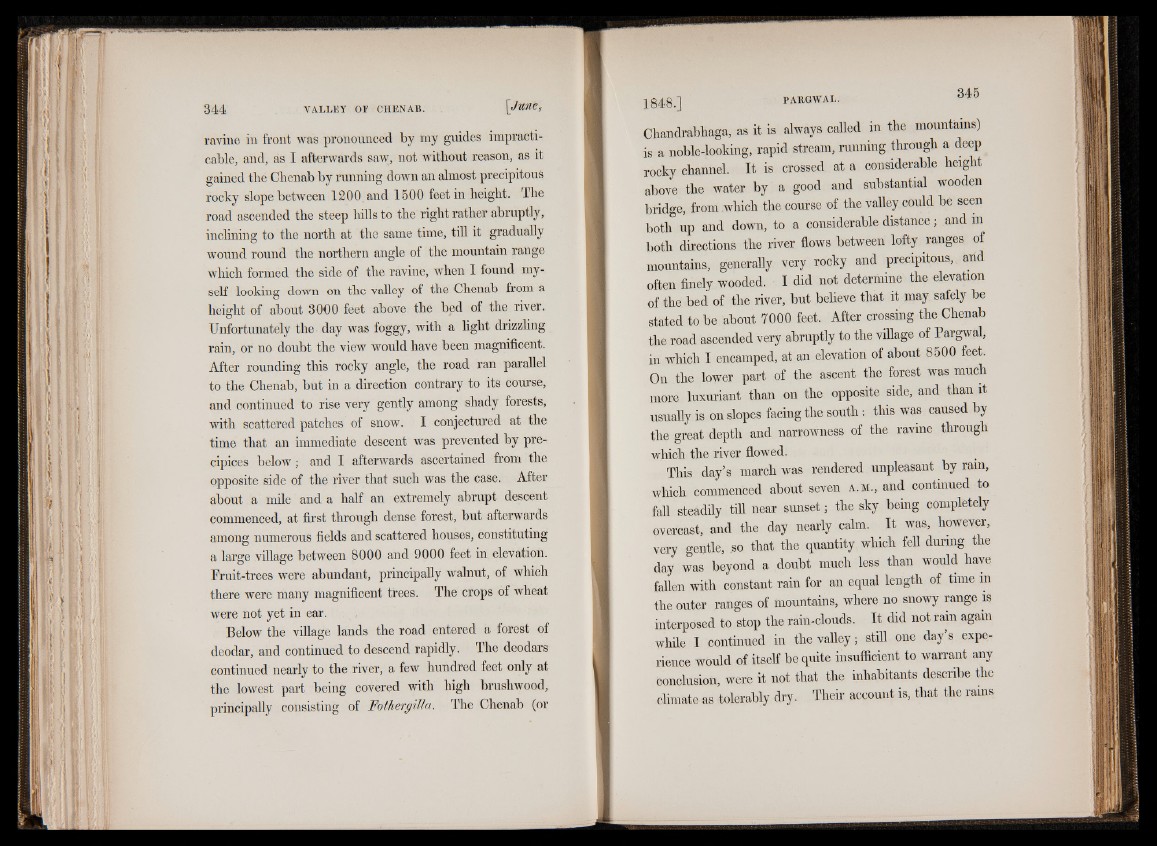
ravine in front was pronounced by my guides impracticable,
and, as I afterwards saw, not without reason, as it
gained the Chenab by running down an almost precipitous
rocky slope between 1200 and 1500 feet in height. The
road ascended the steep hills to the right rather abruptly,
inclining to the north at the same time, till it gradually
wound round the northern angle of the mountain range
which formed the side of the ravine, when I found myself
looking down on the valley of the Chenab from a
height of about 3000 feet above the bed of the river.
Unfortunately the day was foggy, with a light drizzling
rain, or no doubt the view would have been magnificent.
After rounding this rocky angle, the road ran parallel
to the Chenab, but in a direction contrary to its course,
and continued to rise very gently among shady forests,
with scattered patches of snow. I conjectured at the
time that an immediate descent was prevented by precipices
below; and I afterwards ascertained from the
opposite side of the river that such was the case. After
about a mile and a half an extremely abrupt descent
commenced, at first through dense forest, but afterwards
among numerous fields and scattered houses, constituting
a large village between 8000 and 9000 feet in elevation.
Fruit-trees were abundant, principally walnut, of which
there were many magnificent trees. The crops of wheat
were not yet in ear.
Below the village lands the road entered a forest of
deodar, and continued to descend rapidly. The deodars
continued nearly to the river, a few hundred feet only at
the lowest part being covered with high brushwood,
principally consisting of Fothergilla. The Chenab (or
Chandrabhaga, as it is always called in the mountains)
is a noble-looking, rapid stream, running through a deep
rocky channel. It is crossed at a considerable height
above the water by a good and substantial wooden
bridge, from which the course of the valley could be seen
both up and down, to a considerable distance; and m
both directions the river flows between lofty ranges of
mountains, generally very rocky and precipitous,, and
often finely wooded. I did not determine the elevation
of the bed of the river, but believe that it may safely be
stated to be about 7000 feet. After crossing the Chenab
the road ascended very abruptly to the village of Pargwal,
in which I encamped, at an elevation of about 8500 feet.
On the lower part of the ascent the forest was much
more luxuriant than on the opposite side, and than it
usually is on slopes facing the south: this was caused by
the great depth and narrowness of the ravine through
which the river flowed.
This day’s march was rendered unpleasant by ram,
which commenced about seven a .m ., and continued to
fall steadily till near sunset; the sky being completely
overcast, and the day nearly calm. It was, however,
very gentle, bo that the quantity which fell during the
day was beyond a doubt much less than would have
fallen with constant rain for an equal length of tune in
the outer ranges of mountains, where no snowy range is
interposed to stop the rain-clouds. It did not ram again
while I continued in the valley; still one day’s experience
would of itself be quite insufficient to warrant any
conclusion, were it not that the inhabitants describe the
climate as tolerably dry. Their account is, that the rams